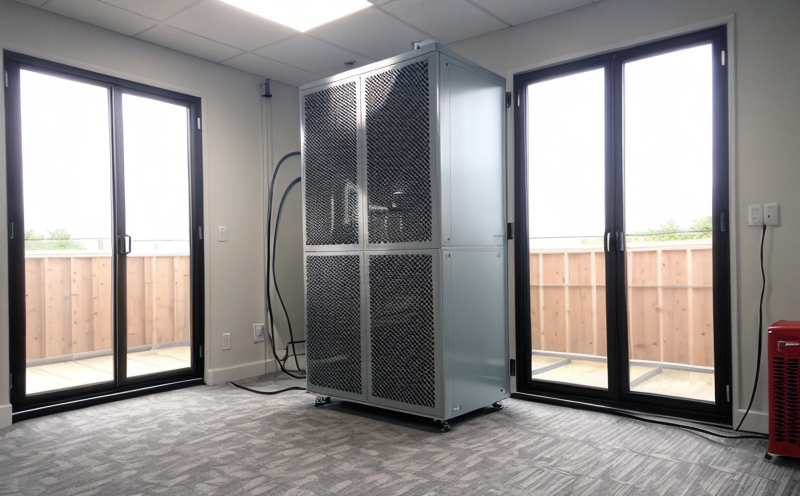Air Handling Unit Flow Balance Test
The Air Handling Unit (AHU) Flow Balance Test is a critical procedure in HVAC equipment testing that ensures optimal airflow distribution within an AHU. This test plays a pivotal role in verifying the operational performance and efficiency of air handling units, which are integral components in maintaining indoor environmental conditions.
During this test, we use sophisticated instrumentation to measure and balance the airflow across various sections of the AHU. The primary objective is to ensure that the supply and return airflows are balanced according to specified standards, such as ASHRAE 55 for thermal comfort or ASHRAE 62.1 for indoor air quality.
The process begins with a comprehensive inspection of the AHU, ensuring all components are in working order before testing starts. This includes checking dampers, fans, and filters to ensure they do not obstruct airflow. Once the system is ready, the test involves measuring the airflow at different points within the unit using anemometers and flow meters.
After collecting initial data, adjustments may be made to the AHU components to achieve balanced airflow. This balancing process ensures that each zone receives the required volume of air to maintain comfortable environmental conditions. Balancing also helps in reducing energy consumption by optimizing fan speeds and minimizing pressure losses.
The test concludes with a detailed report that includes all measurements taken during the procedure, along with recommendations for any necessary adjustments. Compliance with relevant standards such as ASHRAE 55 ensures that the AHU operates efficiently, contributing to better indoor air quality and energy savings.
By conducting this test regularly, facility managers can ensure that their HVAC systems are operating at peak efficiency, thereby extending equipment life and reducing operational costs. The accuracy of airflow measurements is paramount for maintaining environmental control in buildings, making this service a cornerstone of HVAC maintenance practices.
Quality and Reliability Assurance
The Air Handling Unit Flow Balance Test is essential in achieving high-quality outcomes that meet stringent industry standards. At [Lab Name], we employ state-of-the-art equipment and follow internationally recognized guidelines to ensure every test adheres to the highest level of accuracy.
We use precision anemometers, flow meters, and pressure gauges that are regularly calibrated against national standards to maintain their reliability. This ensures that all measurements taken during the test are accurate and can be relied upon for decision-making processes.
Our team of certified technicians is trained in the latest testing techniques and adheres strictly to ASHRAE 55 and other relevant standards. This guarantees that each AHU Flow Balance Test is performed consistently, producing results that are repeatable and verifiable.
The reliability of our testing services extends beyond the immediate test itself. By providing detailed reports with actionable insights, we help facilities identify areas for improvement and implement strategies to enhance overall HVAC performance. Regular maintenance based on these tests can significantly reduce operational costs and ensure long-term sustainability.
At [Lab Name], quality assurance is not just a process; it's our commitment to excellence in every service we provide. Our rigorous adherence to industry standards, combined with meticulous attention to detail, ensures that your HVAC systems are always performing at their best.
Environmental and Sustainability Contributions
- Energy Efficiency: Balanced airflow in AHUs leads to more efficient fan operation. This reduces energy consumption and associated carbon footprints, contributing positively to the environment.
- Air Quality Improvement: Properly balanced airflows ensure that indoor spaces have optimal ventilation, reducing the concentration of harmful pollutants and enhancing overall air quality.
- Cost Savings: By optimizing airflow balance, facilities can achieve significant reductions in operational costs. This includes lower energy bills and reduced maintenance expenses due to prolonged equipment life.
- Sustainable Building Practices: Ensuring HVAC systems are operating efficiently aligns with broader sustainability goals. It supports the development of green buildings that contribute to a healthier planet.
The Air Handling Unit Flow Balance Test is not just about meeting regulatory requirements; it's also about promoting sustainable practices that benefit both the environment and your organization's bottom line. By investing in this service, you are making a tangible contribution to sustainability efforts.
Competitive Advantage and Market Impact
The Air Handling Unit Flow Balance Test offers significant advantages for facilities aiming to maintain or enhance their market competitiveness. Ensuring optimal airflow in AHUs is critical for maintaining indoor environmental quality, which directly impacts tenant satisfaction and productivity.
By conducting regular flow balance tests, organizations can demonstrate their commitment to sustainability and energy efficiency, differentiating themselves from competitors who may not prioritize these factors as thoroughly. This can lead to higher customer retention rates, enhanced brand reputation, and increased market value.
In the context of new construction or renovation projects, ensuring that HVAC systems are operating efficiently aligns with green building certifications such as LEED (Leadership in Energy and Environmental Design). Achieving certification can open doors to lucrative government incentives and attract environmentally conscious clients.
Moreover, a proven track record of conducting thorough and reliable flow balance tests positions your organization as a leader in HVAC maintenance. This not only enhances credibility but also fosters long-term relationships with key stakeholders such as tenants, investors, and regulatory bodies.
The Air Handling Unit Flow Balance Test is more than just a technical service; it's an investment in your facility’s future. By prioritizing this test, you are ensuring that your HVAC systems continue to perform at peak efficiency, which ultimately contributes to the success of your business.





